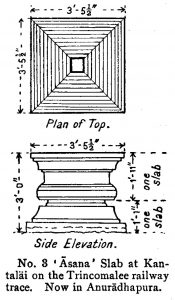OB03085 Kantaläi Gal-Āsana Inscription of Kitti Nissaṅka-Malla
Diagram of the Kantaläi gal-āsana. Published in: Wickremasinghe, Don Martino de Zilva. (1912-27). ‘No. 42. (Reg. No. 3.) Kantaläi Gal-Āsana Inscription of Kitti Nissaṅka-Malla (1187–1196 A.D.),’ Epigraphia Zeylanica 2, p. 283.
IN03105 Kantaläi Gal-Āsana Inscription of Kitti Nissaṅka-Malla
The inscription is engraved around the four sides of a stone seat (gal–āsana), which was discovered in 1921 in the village of Kantaläi on the Trincomalee Railway and afterwards removed to Anurādhapura. The text identifies the stone seat as the one that king Nissaṅka-Malla, after returning from his Indian campaign, used to occupy whilst witnessing the various diversions such as alms-giving, dancing, singing, etc., in the Pārvatī-satra erected at his request in Caturveda-Brahmapura, ‘the city of the Four-Vedic Brahmans’. By way of an introduction, the inscription also includes a bombastic account of Nissaṅka-Malla’s military achievements and charitable acts. Virtually identical accounts are commonly found in other gal-āsana records of this king. The Kantaläi inscription is not dated but, since it references his tours of inspection and his expedition to India, it was probably composed towards the end of his short but eventful reign, which spanned nine years, beginning in 1187 and terminating in 1196. If Kantaläi was the original site of the seat, then this locality must once have been the town called Caturveda-Brahmapura, which was probably occupied mostly by Brahman families for whose benefit an almshouse called Brāhmaṇa-satra was also established by Nissaṅka-Malla.
OB03066 Poḷonnaruva Rankot-Dāgaba Gal-Āsana
Rankoth Vehera, Polonnaruwa.
IN03086 Poḷonnaruva Rankot-Dāgaba Gal-Āsana Inscription
The inscription is engraved around four sides of the smoothed upper surface of a stone seat (āsana). It was discovered in the jungle some two hundred yards to the east of the ruin known as Ran-kot-vehera in Poḷonnaruva. The inscription consists of six lines and dates from the reign of Niśśaṅka-Malla (1187-1196 A.D.). It gives an account of some of Niśśaṅka-Malla’s acts, before identifying the seat as the one which the king occupied to watch the construction of the Ruvanväli-dāgaba at Poḷonnaruva. Wickremasinghe notes that the stone-seat inscription must be earlier than the Galpota inscription (IN03081) because the latter post-dates the completion of the Ruvanväli-dāgaba. This dāgaba was built to a height of eighty cubits and adorned with a golden pinnacle, from which it gets its present name: Ran-kot-vehera (‘golden-spire-monastery’).
OB03065 Poḷonnaruva Kāliṅga Park Gal-Āsana
Niśśaṇka-Malla’s Council Chamber, Polonnaruwa.
IN03085 Poḷonnaruva Kāliṅga Park Gal-Āsana Inscription
The inscription is engraved around four sides of the smoothed upper surface of a stone seat (āsana). It was found outside the ruin of king Niśśaṇka-Malla’s Council Chamber on the promontory overlooking the Tōpa-väva tank in Poḷonnaruva. Consisting of eight lines and dating from the reign of Niśśaṅka-Malla (1187-1196 A.D.), the inscription begins with a panegyrical account of the king’s munificence and some of his acts. This account is similar to that given in Niśśaṅka-Malla’s Dambulla inscription (IN03032) and in the Häṭa-dā-gē Portico slab (IN03078). The inscription then proceeds to state that the ‘lion-seat’ is the one on which His Majesty sat whenever he witnessed the musical performances in the Kāliṅga Park. It also asserts that the stone itself was brought for this purpose from Eṇ̆ḍera-galla, which Wickremasinghe identifies with the village Eṇ̆ḍēru-gala (7.915035, 80.679343), situated about five miles west of the famous rock-fortress Sīgiri and half a mile from Inamalawa on the Dambulla-Trincomalee high road. The exact locality of the Kāliṅga Park, mentioned in this inscription and reputedly formed by Niśśaṅka-Malla, is uncertain. However, if the original site of the present ‘lion-seat’ was somewhere near the spot outside the ruin of the ‘Council Chamber’ where it was unearthed, then the Park must have occupied open ground on the eastern side of the structure.
OB03063 Poḷonnaruva Kāliṅga Forest Gal-āsana
The Quadrangle (Dalada Maluwa), Polonnaruwa, Sri Lanka
IN03083 Poḷonnaruva Kāliṅga Forest Gal-āsana Inscription
The inscription is engraved around four sides of the smoothed upper surface of a granite seat or āsana. In 1927, Wickremasinghe reported that the seat stood a few feet off the south-east corner of the site of a Piḷima-gē (‘image-house’) in the group of ruins on the Tōpa-väva quadrangle (the Dalada Maluwa) in Polonnaruwa. The inscription indicates the āsana as that on which king Niśśaṅka-Malla used to sit whenever he witnessed the dramatic and musical entertainments which were held in the Kāliṅga-vana after his return from his Ceylong tours and his Indian campaign. Niśśaṅka Malla reigned from 1187 to 1196 A.D. According to the Poḷonnaruva Häṭa-dā-gē Vestibule Wall Inscription (IN03079), Niśśaṅka Malla began his journeys around Ceylon in the second year of his reign i.e. 1188-89 A.D. As the present inscription refers to these journeys, it must date from after 1188 A.D.



